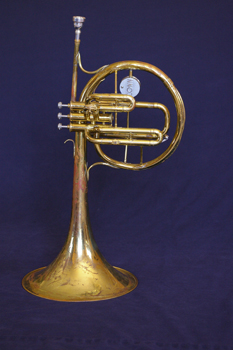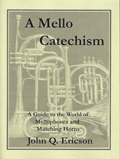My Mellophonium Mood
John Ericson
One thing I became very interested in during the summer of 2007 when I began looking at the mellophone was “classic” jazz Mellophonium playing from the late 50s and early 60s by Don Elliott and also the Stan Kenton Orchestra, one 1962 Kenton recording being Mellophonium Moods, which inspired the title of this article. I had always liked jazz, and I had actually been generally aware of the Mellophone as a jazz instrument for a long time as my high school library had a copy of the Leonard Feather jazz dictionary and I had noticed a couple of mellophone players in it. What really intrigued me the most as I looked into it more was Don Elliott and his sound on this almost forgotten instrument, which slotted in sonically somewhere between a Flugelhorn and horn, a bit like valve trombone and similar to descant horn in ways--but unique. I especially liked what I heard from Don Elliott on the CD release The Paul Desmond Quintet/Quartet, perhaps his best recording. It became a bit of a quest to try to figure out how exactly he produced that sound, as it really is unique and effective in the context. It was not at all the sound I associated with modern marching mellophone.
After a few weeks of trying every variation I could find for mouthpieces on modern marching mellophones and only getting close to “the sound” I came to the conclusion that I better find an actual Mellophonium, an instrument I had never had in my hands, and figure this out once and for all.
 The Mellophonium was an instrument developed by Conn in the late 1950s for use in marching bands. The 16E has a unique, almost iconic form, and was manufactured by Conn for over twenty years. Thanks to eBay I am now the proud owner of this fairly late example that left the factory in 1976.
The Mellophonium was an instrument developed by Conn in the late 1950s for use in marching bands. The 16E has a unique, almost iconic form, and was manufactured by Conn for over twenty years. Thanks to eBay I am now the proud owner of this fairly late example that left the factory in 1976.
The first order of business was to try to figure out if I could get the sound and articulation quality I was looking for to happen. And I believe I got very close right away with a Bach 6 mellophone mouthpiece. It has good focus to the sound but is not overly bright or dark, with a good crisp articulation quality.
It should be noted that this instrument is the last “true” mellophone as it was designed to take a standard, “classic” mellophone mouthpiece. A modern mellophone mouthpiece with a trumpet shank will not fit this instrument; the 16E was made for a mouthpiece that uses a smaller, cornet-style shank like the Bach 6.
I should mention that a cornet mouthpiece will also work but it really is not a good choice. Does not have “the sound” and the intonation is worse. This instrument was clearly designed to use a mouthpiece with a larger cup volume and a wider inner diameter, which was what Don Elliott always used and the Kenton players used early on. Initially they utilized the stock Conn mouthpiece, which was similar to the Bach. Ultimately the section settled on something different, as revealed by former Kenton Mellophonium player Tony Scodwell in an interview in the Middle Horn Leader site.
At this point we were thinking “There’s got to be something better.” …. So at that point I started looking around for better mouthpieces.
Basically, we were all trumpet players at that time (until Dave Horton joined the section–he was a French horn player). I had been playing Schilke trumpets and I knew “Ren” pretty well and I went in to see him. He suggested a “Farkas” cup with our trumpet rims and a shaved down flugel backbore. It’s a funny mouthpiece, but it works really well.
Internally the instrument is a bit different than a modern marching mellophone. As noted, the receiver of the mouthpiece is smaller so it starts a bit smaller but grows to a larger bore, as through the valves it is a full half inch! The throat of the bell is also a bit bigger than that of a King 1120 mellophone.
The intonation is not great but fairly manageable actually, as there is a good bit of flexibility of pitch to the horn. Part of the problem is the valve slides are too long; I had to cut them down. The second slide is about 1/4 inch too long and the first and third slides are about 1/2 inch too long.
On any mouthpiece the high range is, well, not very good. Anything above a written G at the top of the staff is pretty difficult to play and has an unstable quality. But at least the top F is stable on any mouthpiece, as on some mellophones it is not.
As I tried mouthpiece options I found that I could play into the high range with improved stability on my normal Laskey 80G horn mouthpiece (18mm inner diameter) with an adapter. Sound wise it is surprisingly close to the Bach 6 and it retains the focus and articulations; the cup volume and bore are similar. It is interesting to note that Dwight Carver is known to have used a horn mouthpiece on the Mellophonium in the Stan Kenton Orchestra early on and that the Laskey is similar to the Farkas cup mentioned by Scodwell as being used later in the history of the section.
 This testing was all well and good as I developed my publication A Mello Catechism, available through Horn Notes Edition. However, in early 2008 I did something that I never expected that I would do; I played the classic jazz tune Misty on Mellophonium in front of a large audience!
This testing was all well and good as I developed my publication A Mello Catechism, available through Horn Notes Edition. However, in early 2008 I did something that I never expected that I would do; I played the classic jazz tune Misty on Mellophonium in front of a large audience!
This was not something I saw coming but I welcomed. What I performed was a version of Misty slightly re-arranged for brass band (thank you Michelle Kalo) with the Salt River Brass Band. It was a lot of fun. Intonation was a bit of a struggle but the one memory that I can’t shake of the performance was this, the sensation felt while playing it that if I put down the right fingerings I was not going to miss any notes. Mellophonium must be around 30% easier to play accurately than horn. I have never before on a horn solo felt confident to this same level about accuracy; it is not a feeling horn players I think sense often at all. The recording of the performance may be heard at the end of episode 44 of The MelloCast, a podcast for middle brass players.
Is it over? I am not switching over to Mellophonium full time (!!!) but I do hope to play it again at some point, especially if possible the actual original arrangement of Misty with a jazz band. If you are looking for a soloist for a group out there I am available!
For more information visit The Mello Zone in Horn Articles Online and also purchase A Mello Catechism from Horn Notes Edition.
Return to Horn Articles Online, the Internet horn resource by John Ericson